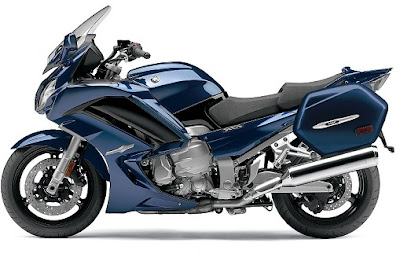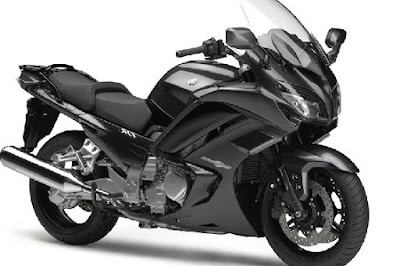Monday, December 19, 2016
2016 Yamaha FJR1300ES Review
What do a state park, a world border crossing, a dust road and a coastal main road have in common? along they create up the four corners of American state. Linking them along during a massive loop covers two,600 miles, that I shoehorned into a bit over 3 days, averaging 800 miles each day, for a difficult take a look at of man and machine aboard the new 2016 Yamaha FJR1300ES.
Since its U.S. debut as a 2003 model, Yamaha’s FJR1300 sport tourer has evolved steady. Minor updates ironed rough edges and addressed shortcomings. ABS was additional here, aeromechanics were improved there and new technologies were introduced. a significant overhaul for 2013 brought additional power, the spoils of throttle-by-wire (engine modes, control and traction control), improved wind protection and luxury, updated instrumentation and new styling, and 2014 saw the introduction of the FJR1300ES, with electronically adjustable suspension. For 2016, the FJR has been any refined with a replacement 6-speed transmission, AN assist-and-slipper clutch, junction rectifier lighting and a spiffed-up electrical device. the quality FJR1300A conjointly gets updated suspension and also the FJR1300ES gets new junction rectifier cornering lights.
Since its U.S. debut as a 2003 model, Yamaha’s FJR1300 sport tourer has evolved steady. Minor updates ironed rough edges and addressed shortcomings. ABS was additional here, aeromechanics were improved there and new technologies were introduced. a significant overhaul for 2013 brought additional power, the spoils of throttle-by-wire (engine modes, control and traction control), improved wind protection and luxury, updated instrumentation and new styling, and 2014 saw the introduction of the FJR1300ES, with electronically adjustable suspension. For 2016, the FJR has been any refined with a replacement 6-speed transmission, AN assist-and-slipper clutch, junction rectifier lighting and a spiffed-up electrical device. the quality FJR1300A conjointly gets updated suspension and also the FJR1300ES gets new junction rectifier cornering lights.
California may be a massive, sophisticated state burdened by gridlocked traffic, high prices of living and burdensome rules and rules (as EIC Tuttle puts it, “if it isn’t necessary it’s prohibited”). however it’s conjointly a state of unmatched beauty, an area wherever various topography, scenic roads and benevolent weather close to form the best setting for bike moving. My goal, additionally to our usual take a look at programme of mixed-use riding and measurements, was to ride around American state in one massive push, to measure on the FJR from sunrise to sunset for many days and see however so much Yamaha’s flagship sport tourer has come back. My route, from coast to abandon to mountains and back once more, ran the gamut, from physical change to triple digits, from processing sand to pound rain, from town traffic to massive freeways to empty back roads.
After many days of traveling and a photograph shoot on native back roads, it absolutely was time to urge all the way down to business. I loaded the FJR’s 30-liter, removable saddlebags (which associate with high-quality zippered liner bags), mounted a tail bag and magnetic tank bag, put in a GPS and attached a heated jacket liner. To avoid rush-hour traffic riding south through l. a. and San Diego, I left my house in Ventura at four a.m. and cruised down the dark, empty main road. 3 hours later I exited at farm marketplace Road, a narrow, busted-up road strewn with sand and gravel and swarming with fast-moving patrol trucks. On the opposite aspect of a vast fence loomed city, therefore shut nonetheless thus far. because the rising sun peeked over a ridge, I born the sidestand during a dirt heap at Border Field State Park in California’s southwest corner. One down, 3 to travel.
During the nonstop superhighway slog, my attention was targeted on comfort and wind protection. With the FJR’s wide, flat seat within the higher of 2 positions, it provided firm support and adequate space for my long legs. The wide seat is snug on the road, however it will create it difficult to urge flat-footed at a stop, particularly for shorter riders. The bar was within the normal position (with tools it are often stirred fore/aft 5mm), permitting Pine Tree State to take a seat virtually upright. With the electrical windshield within the highest position of its five.1-inch vary, my higher body was protected against the wind and flow of air around my helmet was turbulence-free. Lowering the windshield directed wind blast at my chest, taking weight off my wrists, however whether or not high or low the screen is on the little aspect and wind noise are often vexatious. increasing the lower fairing panels helped deflect wind around my legs, and tho' the heated grips unbroken my hands fairly heat, I puzzled why wind-blocking hand guards haven’t found their means onto sport tourers.
After many days of traveling and a photograph shoot on native back roads, it absolutely was time to urge all the way down to business. I loaded the FJR’s 30-liter, removable saddlebags (which associate with high-quality zippered liner bags), mounted a tail bag and magnetic tank bag, put in a GPS and attached a heated jacket liner. To avoid rush-hour traffic riding south through l. a. and San Diego, I left my house in Ventura at four a.m. and cruised down the dark, empty main road. 3 hours later I exited at farm marketplace Road, a narrow, busted-up road strewn with sand and gravel and swarming with fast-moving patrol trucks. On the opposite aspect of a vast fence loomed city, therefore shut nonetheless thus far. because the rising sun peeked over a ridge, I born the sidestand during a dirt heap at Border Field State Park in California’s southwest corner. One down, 3 to travel.
During the nonstop superhighway slog, my attention was targeted on comfort and wind protection. With the FJR’s wide, flat seat within the higher of 2 positions, it provided firm support and adequate space for my long legs. The wide seat is snug on the road, however it will create it difficult to urge flat-footed at a stop, particularly for shorter riders. The bar was within the normal position (with tools it are often stirred fore/aft 5mm), permitting Pine Tree State to take a seat virtually upright. With the electrical windshield within the highest position of its five.1-inch vary, my higher body was protected against the wind and flow of air around my helmet was turbulence-free. Lowering the windshield directed wind blast at my chest, taking weight off my wrists, however whether or not high or low the screen is on the little aspect and wind noise are often vexatious. increasing the lower fairing panels helped deflect wind around my legs, and tho' the heated grips unbroken my hands fairly heat, I puzzled why wind-blocking hand guards haven’t found their means onto sport tourers.
 |
| Yamaha FJR1300ES 2016 |
After a gas stop, I headed east. American state is long and slender, averaging virtually 800 miles from north to south and 250 miles east to west, and its southern border is shared with Mexico a line that’s simply a hundred and forty miles long. ripping lanes through rush-hour traffic took Pine Tree State to interstate eight, that climbs over the Cuyamaca Mountains, crosses the Tecate Divide and drops down a winding grade into the recent, dry Calif.. Paralleling the border, the tract went from sandy and rocky to inexperienced and fertile within the well-irrigated Imperial natural depression. East of El Centro, I crossed a canal and was shortly riding among high dunes as sand drifted across the road, then many miles south on State Route 186 took Pine Tree State to the border crossing at Andrade. when four hundred miles and 6 hours of seat time, I had labelled California’s 2 southern corners.Folks are clamour for a sixth gear on the FJR for an extended time, and Yamaha has finally done it. however the new transmission goes on the far side simply an additional cog and has reworked the riding expertise with exceptionally fluid and precise gear changes. By separating the shift dog from the gears, Yamaha saved enough area to permit for the addition of a sixth gear while not creating the transmission larger, and new helical-cut gears cut back lash and noise. the ultimate drive quantitative relation is slightly taller (2.693 vs. 2.773), the quantitative relation unfold for gears 1-5 is narrower (with taller first and 2d gears and shorter fourth and fifth gears) and also the new sixth gear reduces engine speed by regarding ten % compared to fifth gear on the previous model. The result's slightly less snap within the lower gears, faster acceleration in gears 4-5 and additional relaxed main road riding in prime gear.
Labels:
YAMAHA
Subscribe to:
Post Comments (Atom)

No comments:
Post a Comment
Note: Only a member of this blog may post a comment.